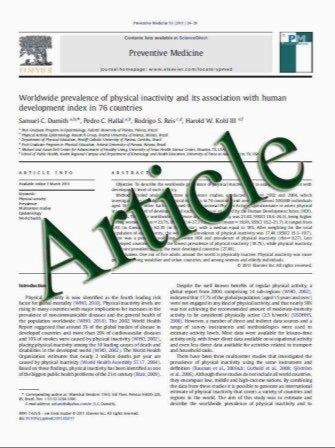A study of relationships between bone-related vitamins and minerals, related risk markers, and subsequent mortality in older British people: the National Diet and Nutrition Survey of People Aged 65 Years and Over
- نوع فایل : کتاب
- زبان : انگلیسی
- مؤلف : C. J. Bates & M. Hamer & G. D. Mishra
- چاپ و سال / کشور: 2011
Description
Summary Follow-up of a British national survey of older people found that in men, all-cause mortality was predicted by baseline plasma concentrations of phosphorus, albumin, creatinine and ل1-antichymotrypsin, and food energy intake and in women by plasma alkaline phosphatase, creatinine, ل1- antichymotrypsin, 25-hydroxy-vitamin D (marginally), and phosphorus intake. Introduction Predictive power, for all-cause mortality, of bone-related vitamin and mineral indices and intakes, measured at baseline (primary objective), was studied in the British National Diet and Nutrition Survey (community-living subset) of People Aged 65 Years and Over. A secondary objective was to identify cross-sectional relationships between indices at baseline to help explain mortality predictions. Methods Mortality status was recorded for 1,054 (mean age 76.6±7.4 years, 49.0% female) participants from baseline survey in 1994/1995 until September 2008. Seventy-four per cent of male and 62% of female participants died. Cox proportional hazards models were used to relate baseline nutrient and risk marker estimates to subsequent survival. Results below 1.0 signified lower risk at greater nutrient (status or intake) values and vice versa. Results In both sexes, all-cause mortality was significantly predicted by body weight and mid-upper arm circumference. In men, it was predicted by baseline plasma concentrations (per SD) of: phosphorus (hazard ratio 1.18, 95% confidence interval (CI)=1.06–1.30), albumin (hazard ratio 0.84, 95% CI =0.74–0.94), creatinine (hazard ratio 1.20, 95% CI=1.08– 1.33) and ل1-antichymotrypsin (hazard ratio 1.21, 95% CI= 1.11–1.33). In women, it was predicted by plasma albumin (hazard ratio 0.83, 95% CI=0.72–0.96), alkaline phosphatase (hazard ratio 1.08, 95% CI=1.01–1.16), creatinine (hazard ratio 1.37, 95% CI=1.13–1.66), ل1-antichymotrypsin (hazard ratio 1.27, 95% CI=1.11–1.45) and marginally by 25- hydroxy-vitamin D (hazard ratio 0.87, 95% CI=0.75–1.00). In men, it was predicted by dietary intake (per SD) of food energy; in women, by intake of phosphorus. Adjustment for plasma ل1-antichymotrypsin or plasma creatinine reduced the significance of plasma phosphorus in men. Conclusion Mortality prediction by higher plasma phosphorus in older British men may imply impaired renal function and/or acute phase status. Further studies are needed on which associations are causal and modifiable.
Osteoporos Int DOI 10.1007/s00198-011-1543-z Received: 16 August 2010 / Accepted: 10 January 2011


